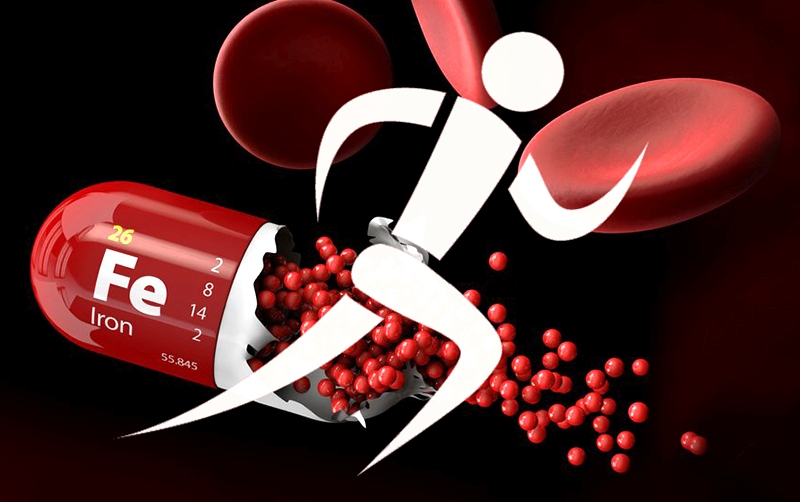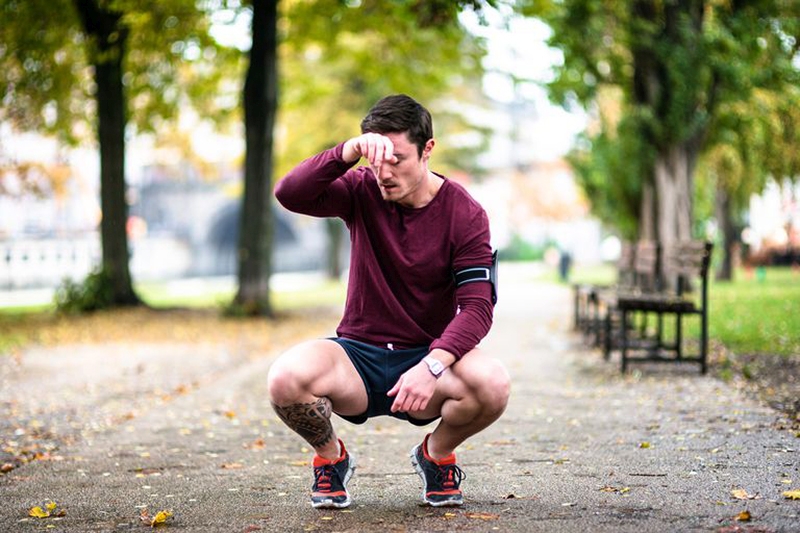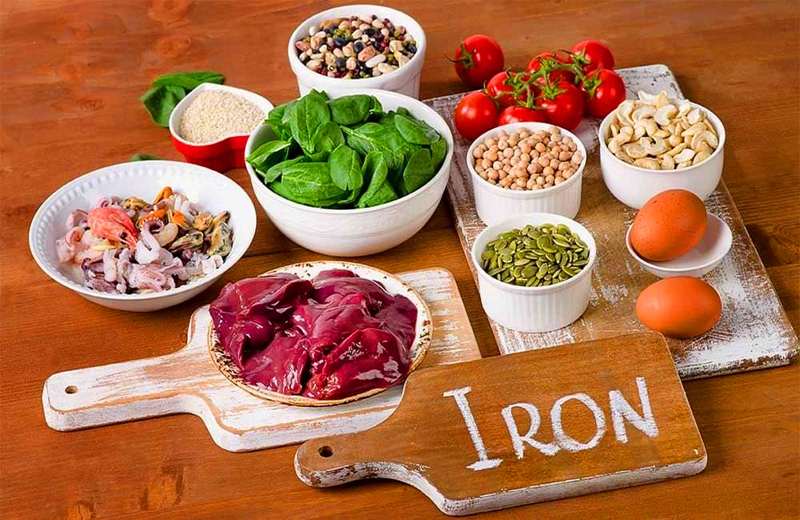You are viewing 1 of your 1 free articles. For unlimited access take a risk-free trial
Steel your performance - with probiotics!
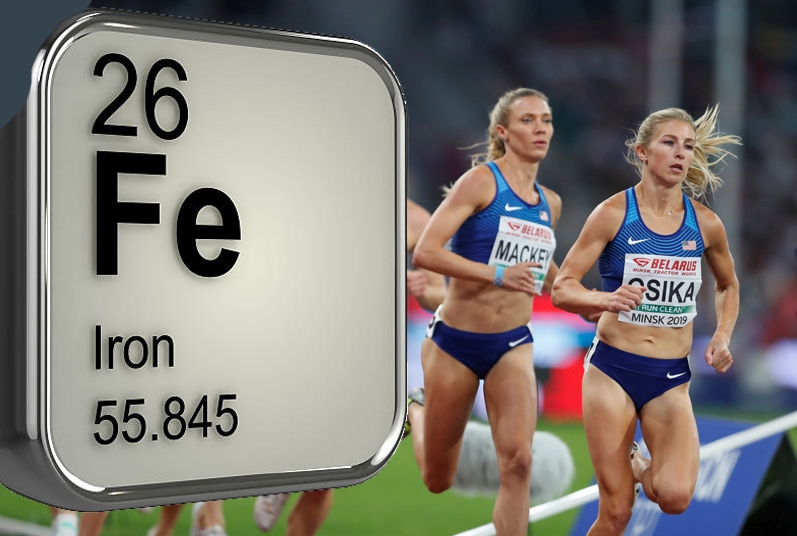
Andrew Hamilton looks at some intriguing new evidence that better gut health via probiotic use can improve your iron status - a vital nutrient for endurance performance
Most of you know (or should know!) that iron is a mineral required for the formation of red blood cells used to transport oxygen around the body to hard working muscles. It’s also common knowledge that a shortfall of iron can result in fatigue, listlessness and a general lack of energy. However, what you may be less aware of is that iron is one of the most difficult minerals to absorb, and that as an athlete, you could be especially vulnerable to iron depletion through training-induced losses, especially if your event involves running and/or you undertake a high volume of training. To make matters even more complicated; the iron in many foods (especially vegetable foods), isn’t always easy to absorb and is made more difficult by things like tea, coffee and dietary fibre which further impede iron absorption. Female athletes face additional problems due to monthly menstrual blood losses.Why iron matters
Over the last 10-15 years, a large body of research has emerged demonstrating the vital importance of optimum iron nutrition in endurance performance. For example, studies have shown that a compromised iron status - even without any obvious iron-deficiency anaemia being present –negatively impacts both physical performance and the adaptation response to training (the amount of fitness gains observed per unit volume of training workload)(1-3). In short, if your iron status is sub optimum, you won’t respond as well to training and you won’t race as well.How common is sub-optimum iron in athletes? The answer is surprisingly common, even among those with good diets. For example, research has established that the prevalence of sub-optimum iron (and outright iron deficiency) in female athletes typically ranges from 10-38% of all those engaging in competition(4-6). Furthermore, we know that it’s the training itself that seems to negatively impact on iron status as studies have shown that levels of iron in an athlete’s body change according to the phase of the training season, improving in the off season and declining in the active season(7,8).
Male athletes too
Although female athletes are known to be particularly prone to sub-optimum iron (as a result of the monthly menstrual cycle and a lower calorie [and therefore iron] intake), male athletes are by no means immune from this problem. In one excellent study on this topic, researchers retrospectively examined the blood test results collected from 38 elite male and female runners and triathletes over a 6-year period from 2009-2015(9). In particular, they looked at levels of serum ferritin (an iron-storage protein circulating in the blood) and haemoglobin (the iron-containing molecule in red blood cells that transports oxygen around the body). They also questioned the athletes about their use of iron supplements during that period to see how protective iron supplementation had been against iron deficiency.The first finding was (in line with other studies) that the incidence of iron deficiency among the runners and triathletes was higher than might be expected. In fact, it was actually significantly higher than that reported for endurance athletes in previous studies. The second finding was that this higher incidence was reported for both male and female athletes; indeed, the male athletes had actually suffered from HIGHER levels of iron deficiency than their female counterparts!
Does iron supplementation work?
If getting enough iron from the diet is a problem, why not just take iron supplements I hear you ask? The problem is that taking iron is one thing, but absorbing that iron from the gut and getting it the tissues in the body that need it is another matter. In the study on runners and triathletes above(9), while some of the athletes routinely used iron supplements (or had been prescribed them following testing), there seemed to be no relationship between supplement use and subsequent iron status – ie the supplements didn’t appear to offer a protective effect against deficiency. This seems to be borne out by other studies that have demonstrated the following issues with iron supplementation:- #Iron supplementation administered to those with a sub-optimum iron status but who were not anaemic did not seem to improve physical performance(2).
- #Although a significantly proportion of athletes have been shown to use iron supplements, a large proportion of the ingested iron typically remains in the gut, necessitating higher intakes, potentially resulting in adverse side effects and a limited ability to efficiently replete iron stores(10,11).
- #High-dose iron can irritate the intestine, resulting in gastrointestinal discomfort. Add on a heavy training load - which can also be stressful for the intestinal tract(12) - and you have a potentially unpleasant combination.
- #Some data indicates that non-absorbed iron could be harmful by adversely modifying the gut microbiota, and increasing the concentration of intestinal pathogens(13).
Probiotics: making better use of iron?
Iron is a key nutrient for performance, but taking high-dose supplements comes with potential drawbacks, and may not even help improve iron status. What would be preferable is a way of increasing the absorption of ingested iron, therefore obviating the need for high-dose supplements. Fascinating new research suggests that one possible way of doing this could be to improve gut flora with a probiotic(14). In this study, 53 healthy female athletes were randomised into two groups:- *The iron-only group took 20mgs per day of iron as ferrous fumerate for 12 weeks.
- *The iron + probiotic group two took the same amount of ferrous fumerate but also took a daily probiotic supplement of Lactobacillus plantarum 299v (Lp299v) for 12 weeks.
To create a meaningful comparison, all the subjects were instructed not to consume any probiotic products, additional iron supplements, vitamin C supplements (which can affect iron absorption) during the study. Subjects were also asked to avoid any other changes in their intake of dietary supplements and to avoid major changes in dietary habits. Additionally, the subjects could not donate or receive blood during the study (which would have altered iron levels).
The results
The key findings were as follows:- *Both groups improved their iron status after 12 weeks.
- *The Lp299v group improved their iron status slightly more than the iron-only group (a 70% increase in plasma ferritin after intake of Lp299v with 20mg of iron as compared to 42% after 20mg iron alone), but the difference was too small to be considered significant.
- *By contrast, the subjects in the Lp299v group who started off with a baseline level of ferritin mildly below normal (between 20-30g per litre), experienced a much more rapid improvement in iron status than those in the iron-only group with the same status (see figure 1).
- *The Lp299v group reported higher levels of energy and ‘vigour’ after 12 weeks, whereas those in the iron-only group experienced no improvements.
Figure 1: Improvement in iron status in deficient vs. mildly deficient athletes(14)
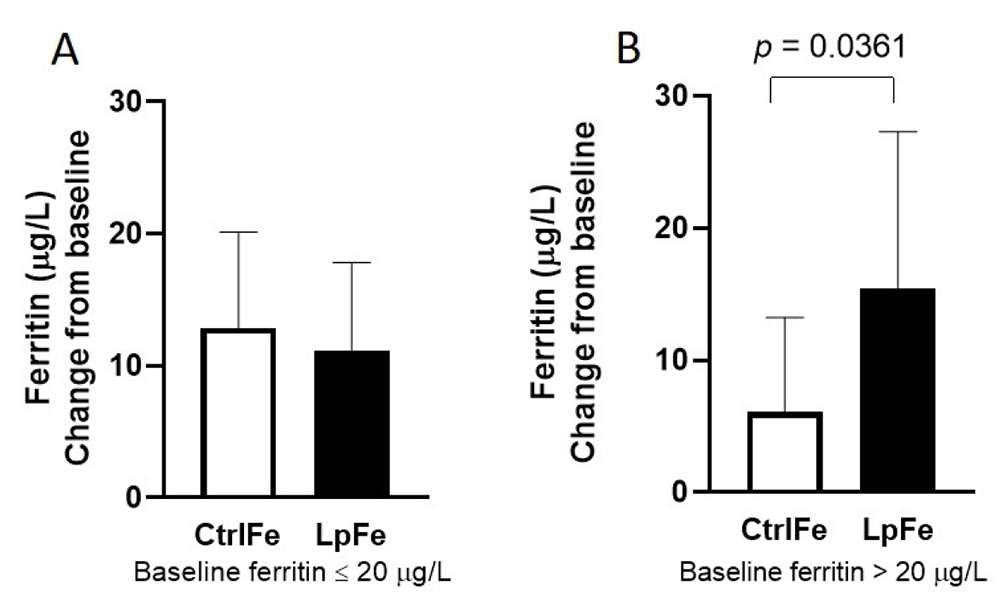
Change from baseline in plasma (blood) ferritin after four weeks of intervention in subjects with a deficient ferritin level (below 20mg/L - A) and mildly deficient ferritin level (between 20 and 30mg/L - B). The ‘p’ value of 0.036 indicates a highly significant difference in improvement for the mildly deficient subjects, whereas there were no real differences for the deficient subjects.
The key finding from this study was that the probiotic Lactobacillus plantarum was able to raise iron status more rapidly in iron-supplementing athletes than in athletes who took iron alone. This effect was particularly noticeable in athletes who were mildly iron deficient; these athletes experienced a rapid improvement in just four weeks – an ideal scenario for an athlete who discovers that he/she is sub-optimum in iron and wants to put things right rapidly. This finding is consistent with other studies that have found a link between Lactobacillus plantarum supplementation and improved iron status(15,16).
Another key finding was that the Lp299v group experienced improved energy and vigour – significant because even a mild shortfall of iron is known to reduce these attributes. It’s worth mentioning as well that the probiotic-supplemented group also experienced significantly fewer upper respiratory tract infections (coughs, colds, sore throat etc) than the iron-only group, suggesting there was a benefit for immune function. Although the researchers weren’t looking for this effect, this observation ties in with other recent data showing that Lactobacillus plantarum confers improved immunity against respiratory viruses(17,18).
Practical advice
Maintaining an optimum iron status is critical for endurance performance. If this can be achieved without resorting to high-dose iron supplements, so much the better. The use of Lactobacillus plantarum probiotics seems to offer real benefits, particularly for those who are mildly iron deficient and want a rapid optimisation of iron levels. We also know that taking Lactobacillus plantarum seems to enhance iron absorption not just from supplements, but from food too(19). Add in the potential immune-boosting effects and there’s a lot to like. Ideally of course, we need more research to clarify the potential benefits of Lactobacillus plantarum, but given there are no downsides (apart from cost), those who are prone to iron deficiency could do a lot worse than give it a try!Practical tips
In addition to Lactobacillus plantarum, try these tips to help ensure you maximise your dietary iron intake without resorting to iron supplements:- Non-vegetarians - try to include some lean cuts of red meat in your diet once or twice each week.
- Vegetarians - try to include more beans (especially lima beans), lentils, dark green leafy vegetables in the diet, as well as eggs and nuts, and other iron-rich foods.
- All athletes - try to consume plenty of vitamin C-rich foods (citrus fruits, berries, new potatoes, broccoli, sprouts, tomatoes, peppers, kiwis etc with your iron-rich foods. Vitamin C helps convert dietary iron into its most absorbable form in the body, which can increase uptake from the gut.
- Consider baking your own bread using teff flour; teff is much richer in iron than other whole grains and makes a great iron-rich carbohydrate food!
- Don’t drink tea and coffee with your meals; the natural tannins present in these drinks strongly bind any iron present, making it less available to the body.
- Don’t use bran or other products with added bran. Bran is high in compounds that bind iron and make it less absorbable. If you want more fibre in your diet, get it by eating whole grain breads and cereals in the first place.
- Cook using stainless steel cookware – it can add useful amounts of iron to cooked foods.
- Don’t take iron supplements without a proven need; the use of high-strength iron supplements for long periods of time can induce toxicity. If you think you are a high risk of iron insufficiency, ask your GP for an iron status test and one that includes serum ferritin as well as haemoglobin.
References
- J. Nutr. 2001, 131, 676S–690S
- Sports Health 2018, 10, 400–405
- Int. J. Sport Nutr. Exerc. Metab. 2011, 21, 501–506
- PLoS ONE 2013, 8, e58090
- J. Int. Soc. Sports Nutr. 2014, 11, 50
- Boil. Sport 2017, 34, 111–118
- Eur. J. Appl. Physiol. 2008, 102, 703–709
- Int. J. Sport Nutr. Exerc. Metab. 2004, 14, 30–37
- Clin J Sport Med. 2017 Sep;27(5):493-498
- PLoS ONE 2015, 10, e0117383
- Biochim. et Biophys. Acta (BBA)-Bioenerg. 2017, 1864, 399–430
- PLoS ONE 2012, 7, e29968
- Nutrients. 2020 Apr 30;12(5). pii: E1279
- Br. J. Nutr. 2015, 114, 1195–1202
- J. Int. Soc. Sports Nutr. 2019, 16, 62
- J Microbiol Biotechnol. 2018 Jun 28;28(6):893-901
- J Immunol. 2019 Feb 1;202(3):871-882
- PLoS One. 2017 Dec 13;12(12):e0189141
Newsletter Sign Up
Testimonials
Dr. Alexandra Fandetti-Robin, Back & Body Chiropractic
Elspeth Cowell MSCh DpodM SRCh HCPC reg
William Hunter, Nuffield Health
Newsletter Sign Up
Coaches Testimonials
Dr. Alexandra Fandetti-Robin, Back & Body Chiropractic
Elspeth Cowell MSCh DpodM SRCh HCPC reg
William Hunter, Nuffield Health
Keep up with latest sports science research and apply it to maximize performance
Today you have the chance to join a group of athletes, and sports coaches/trainers who all have something special in common...
They use the latest research to improve performance for themselves and their clients - both athletes and sports teams - with help from global specialists in the fields of sports science, sports medicine and sports psychology.
They do this by reading Sports Performance Bulletin, an easy-to-digest but serious-minded journal dedicated to high performance sports. SPB offers a wealth of information and insight into the latest research, in an easily-accessible and understood format, along with a wealth of practical recommendations.
*includes 3 coaching manuals
Get Inspired
All the latest techniques and approaches
Sports Performance Bulletin helps dedicated endurance athletes improve their performance. Sense-checking the latest sports science research, and sourcing evidence and case studies to support findings, Sports Performance Bulletin turns proven insights into easily digestible practical advice. Supporting athletes, coaches and professionals who wish to ensure their guidance and programmes are kept right up to date and based on credible science.
